| |
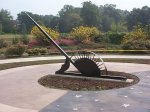 |
Hollidaysburg |
Pennsylvania |
USA |
Horizontal Dial |
Dial 437 |
| This is a large horizontal dial 10 feet in diameter, constructed of marble with a steel gnomon. The sundial was donated in honor of Courtney Leigh Clayton and is open to the public as part of the beautiful Discovery Garden. |
| |
| |
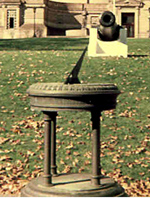 |
Pittsburgh |
Pennsylvania |
USA |
Horizontal Dial |
Dial 436 |
| Horizontal dial about 24 inches in diameter. The stone pedestal is decorated with bronze plaques and Veterans of Foreign War seals on each of the four sides. Now has an open metal base |
| |
| |
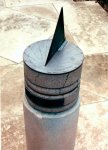 |
Toronto |
Ontario |
Canada |
Horizontal Dial |
Dial 435 |
| A small bronze 8 inch diameter horizontal dial, sitting upon a granite column of equal diameter. The dial plate has simple radiating hour lines and Roman numerals. No minute or quarter hour marks. The gnomon may have broken off at some time and been repaired, since it is now held on by a rather unsightly bronze angle iron. |
| |
| |
|
Jersey City |
New Jersey |
USA |
Horizontal Dial |
Dial 434 |
| A horizontal dial 12 feet across made of concrete and pipe. |
| |
| |
 |
Toronto |
Ontario |
Canada |
Horizontal Dial |
Dial 433 |
| A striking 30 inch diameter horizontal dial. The equation of time correction is made by a slight rocking of the gnomon about the polar axis, controlled by a manual date index and a hidden cam mechanism. At the south end of the gnomon on the dial is a sunburst design. The octagonal pedestal is ornately covered with six copper plates. Each showing two zodiac signs in relief, forming a frieze 20 inches high around the pedestal. |
| |
| |
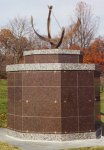 |
Fairfax |
Virginia |
USA |
Equatorial Dial |
Dial 432 |
| This bronze equatorial dial is about four feet in diameter with a 6 inch equatorial band containing raised Roman hour numbers from 5am to 7pm. The band is graduated every ten minutes and is offset by approximately 8 minutes to read Eastern Apparent Time. The gnomon is a simple arrow without nodus and the dial does not have an analemma. The octagonal dial base is made of brown marble panels approximately 5 feet high with a smaller octagon on top approximately 1 foot high that supports the dial. Each octagon is capped with thick granite. The base is a mausoleum, with alternate octagonal sides each containing 8 crypts. |
| |
| |
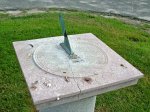 |
Wellesley |
Massachusetts |
USA |
Horizontal Dial |
Dial 431 |
| A small 14x14 inch rose granite square dial with an unassuming 5 inch high brass gnomon sits upon a round white 3 foot high granite column. At the base is a larger granite block. Built about 1899. |
| |
| |
 |
Kalamazoo |
Michigan |
USA |
Analemmatic Dial |
Dial 430 |
| A modernistic analemmatic dial. The ellipse is a raised stone wall with large Arabic numbers for each hour from 5am to 7 pm. The concrete patio in front of the wall contains the analemmatic line of months as an indicator of where to stand for casting the shadow. |
| |
| |
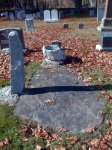 |
East Hartland |
Connecticut |
USA |
Noon Mark or Meridian Dial |
Dial 429 |
| This upright stone was originally a noon marker at Nathaniel Taggart's inn in colonial North Blandford, MA. The stone was moved by Taggart's granddaughter Polly Taggart Church to Harland, CT, where she lived following her marriage. In 1935 the stone was set up in the Hartland Cemetery, casting its noon day shadow onto a flat stone with an engraved meridian line. |
| |
| |
|
Sebastopol |
California |
USA |
Obelisk or Vertical Gnomon |
Dial 428 |
| This is a vertical obelisk 3 foot on a side and 9 foot tall. It is more of a sun calendar than a sundial. The tip of the obelisk's shadow is tracked by marks on a concrete pad on the ground. The summer and winter solstices and equinoxes are indicated by tiles set in the pad. |
| |
| |
|
Newcastle |
Maine |
USA |
Horizontal Dial |
Dial 427 |
| A small horizontal dial with an interesting history. In 1997 when the dial was installed, the following is quoted of designer and builder Jim Estey: "We set it by our watches," Jim said, and then glued it down to its stand. That means it cannot be reset when the sun and time changes, but visitors will have to compensate." |
| |
| |
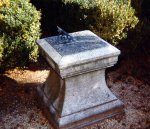 |
Portland |
Connecticut |
USA |
Horizontal Dial |
Dial 426 |
| An 18x18 inch square horizontal sundial with ornate engraving. Along the edge are Roman numerals telling the hours. The gnomon is equally ornate. Both dial plate and gnomon are made of brass. Dial sits on a tapered granite pedestal with a square granite cap. |
| |
| |
 |
Nashville |
Tennessee |
USA |
Vertical Dial |
Dial 425 |
| A 6 x 7 foot vertical dial declining 16.4 deg east of south. The dial of limestone is integral to the building with a near square face, engraved lines and a small triangular gnomon. Hour marks are from 6am to 4pm, labeled between long hour lines. Solar declination lines are shown as dotted lines for the zodiac, including solstices and equinox. This dial was on the 2022 NASS Conference dial tour of Nashville. |
| |
| |
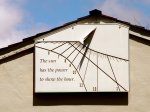 |
San Carlos |
California |
USA |
Vertical Dial |
Dial 424 |
| This vertical dial is approximately 4 foot high by 6 foot long, mounted on the end wall of a house that can be publicly viewed. Dial has hour lines and lines marking the equator and solstice shadow limits. Made of wood and brass. |
| |
| |
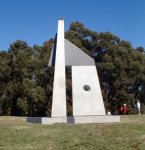 |
Berkeley |
California |
USA |
Sculpture/Artwork |
Dial 423 |
| This is a large granite statue by Richard O'hanlon entitled "Sunstone II" and was designed in collaboration with astronomer David Cudaback. A north-south large polished granite slab has the top cut at the latitude of 38 degrees to sight the North Star. A hole in the stone allows east or west viewing, with limiting angles designed to show the extent of maximum planetary and lunar wandering. An east-west stone crosses the north side of the granite slab, allowing light to pass only at noontime onto a heel stone with marks for Equinox and Solstice. Access by admission to the Hall of Science museum |
| |
| |
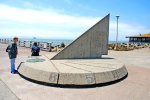 |
Berkeley |
California |
USA |
Horizontal Dial |
Dial 422 |
| At the edge of the bay is a round horizontal sundial about 10 feet in diameter with a stark triangular gnomon. Both gnomon and dial base are of hammered concrete. The base rises above the ground by about 2 feet where Arabic numbers encircle the dial to tell the hours. The dial face is not quite level, perhaps to help with water runoff. |
| |
| |
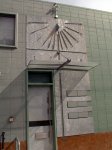 |
San Francisco |
California |
USA |
Vertical Dial |
Dial 421 |
| Dial is on an outside wall above the entrance to a private residence. The dial was designed by Stan Musilek. The dial back is made out of galvanized steel. Metal rails indicate the hours. Instead of Arabic or Roman numerals, the proper number of steel balls indicate the time of each hour. Overall, the dial is 4 by 6 feet. |
| |
| |
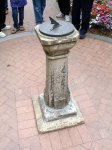 |
San Francisco |
California |
USA |
Horizontal Dial |
Dial 420 |
| A small 10-inch cast iron dial from England honors Shakespeare in a garden of the same name. The dial is on a small pedestal in the middle of the courtyard walkway and surrounded by trees. Lovely, but many shadows pass over the dial during the day. The dial plate was made for latitude 54 degrees. The gnomon appears to have been cut down to accommodate the 38 degrees for San Francisco. This "hack" method of correcting a sundial does not give correct time. |
| |
| |
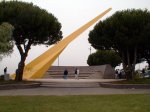 |
San Francisco |
California |
USA |
Horizontal Dial |
Dial 419 |
| Hilltop Park was built by the San Francisco Redevelopment Agency in 1987. The Landscape Architect was Michael Painter and Associates. Here is a giant sundial 70 feet in diameter with a bright yellow painted steel gnomon 78 feet long. The dial has a cement base and was designed to be used as the stage for a surrounding amphitheater. Dial shows wear and abuse, with graffiti covering the lower portion of the gnomon. Still, it is awe inspiring. |
| |
| |
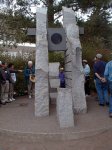 |
San Francisco |
California |
USA |
Sun Alignment |
Dial 418 |
| This is a 16 ton granite statue by Richard O'Hanlon entitled "Sunstone I" and was designed in collaboration with astronomer David Cudaback. A small wall of rock with a round inlay of dark stone is supported high upon two tall vertical slabs of granite. At the back is a "heel stone" with marks to show where the sunlight strikes at the Equinox and Solstice. |
| |
| |
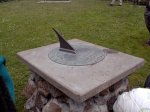 |
San Francisco |
California |
USA |
Horizontal Dial |
Dial 417 |
| A plain but nicely done brass horizontal dial about 2 feet in diameter mounted on a simple concrete pedestal. The dial is in good condition, but about 50 degrees out of alignment. |
| |
| |
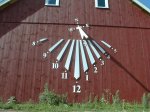 |
Manchester |
Vermont |
USA |
Vertical Dial |
Dial 416 |
| A beautiful vertical declining dial, done in white lines and numerals on the side of a red barn. Made of metal and wood, the overall height is about 15 feet. The dial has a clean, modern design using tapered hour lines and simple gnomon. The Arabic numerals for each hour are graded in size to match the size of their hour line, with the largest at noon and the smallest at 8am and 5pm. |
| |
| |
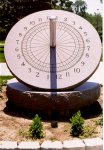 |
Lincoln |
Nebraska |
USA |
Equatorial Dial |
Dial 415 |
| The Carroll Moore Memorial Dial is an equatorial disk dial built by Cold Spring Granite Co. The granite base weighs 6,270 lbs. and is about 6 ft. in diameter. The granite dial plate weighs 3,420 lbs. and is 5 ft. 8 in. in diameter. The stainless steel 5 inch gnomon rod weighs 200 lbs and is approximately 6 feet long from end to end through the equatorial disk. The dial face has hour marks for all 24 hour hours, placed for symmetrical effect rather than for practical time telling. The hours are rotated slightly to account for longitude so that 12:30 is the nearly vertical hour line. |
| |
| |
 |
Toronto |
Ontario |
Canada |
Equatorial Dial |
Dial 414 |
| An equatorial dial with rod gnomon bent into a half analemma. Raised Roman numerals along the equatorial arc from V in morning to VII at night. The gnomon is held by semi-circular arc with pleasing proportions that match the equatorial arc. |
| |
| |
 |
Toronto |
Ontario |
Canada |
Armillary Sphere |
Dial 413 |
| Armillary dial about 4 foot in diameter. Gnomon rod appears to be missing. Raised Roman numbers show the hours from V in the morning to VII at night. Equatorial strip is about 6 inches wide. |
| |
| |
 |
Poughkeepsie |
New York |
USA |
Horizontal Dial |
Dial 412 |
| Small horizontal brass dial, about 12 inches in diameter with classical design. Roman numerals for hours with dots for quarter and half hours. Sits on fluted column about 3 foot high. Beautifully set in the Shakespeare Garden. |
| |
| |
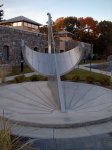 |
Suffern |
New York |
USA |
Compound Dial |
Dial 411 |
| Robert Adzema has designed a 10-foot tall, 12-foot long combination equatorial and horizontal dial made out of stainless steel. The equatorial dial has a wide arc showing hours from 6am to 6pm. At the noon hour is a 31-inch analemma illuminated by a 1/4-inch nodus in a rod gnomon. The pedestal holding the dial and rod is designed as the gnomon for an even larger horizontal ground level dial that surrounds the equatorial dial. For this horizontal dial, the hour lines are made of half-inch stainless steel bars are embedded in concrete. An inscription tells how to tell the time. |
| |
| |
|
Palisades |
New York |
USA |
Equatorial Dial |
Dial 410 |
| An equatorial dial in bronze. Has analemma at the noon hour mark. Lamont-Doherty Sundial Fountain. |
| |
| |
 |
Queens |
New York |
USA |
Vertical Dial |
Dial 409 |
| A 20 foot high x 15 foot wide x 4 foot deep painted aluminum vertical dial entitled '"Winged Shadows." Has declination lines for the solstices and equinoxes. Declines west. On the back wall of the Main Building. Can be viewed from Woodside Ave. Designed by Robert Adzema in 1987. |
| |
| |
 |
Macedon |
New York |
USA |
Sun Alignment |
Dial 408 |
| A cornfield maze for the summer of 2000 at Long Acre Farms. Theme called "Lost in Time" features a number of sundials. The 400 x 500 foot cornfield maze, called the "largest living sundial", is in the form of a smiling sun with 12 corn hedge "rays" from 8 am to 6 pm that align in azimuth to the hour and half hour for Labor Day, 2000. Within each hedge is a vertical pole holding an "Eye of Kala" (an annulus) 12 feet above the ground that casts a spot of light across a hedge clearing at the appointed time to a sign at ground level. At the center of the maze is a horizontal dial with a 12-foot gnomon. This gnomon forms part of the smiling sun's nose when seen from the air. Just outside the corn hinge is an analemmatic sundial for visitors to tell time before going through the hinge. In the hinge, visitors are given a small altitude card dial that tells Eastern Daylight Time from June - Oct. Admission fee. |
| |
| |
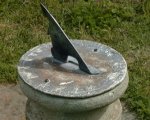 |
Starr's Point |
Nova Scotia |
Canada |
Horizontal Dial |
Dial 407 |
| A small horizontal dial, 8-inches in diameter. The dial is a fiberglass reproduction with metal gnomon upon a cement pedestal. The original dial dates from the 1820s and judging from the reproduction, is in very poor condition. Has Roman numerals, but the hour lines do not agree with the gnomon position. Very difficult to read. North edge of gnomon is cut to resemble a face in profile, possibly in reference to the inscription. On the grounds of the Charles Ramage Prescott House, built 1814 - 1816. Prescott was a merchant and horticulturalist. |
| |
| |
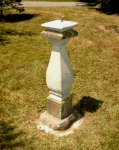 |
Windsor |
Nova Scotia |
Canada |
Horizontal Dial |
Dial 406 |
| A small horizontal dial with an 11-inch square base. The dial was made in 1845, but the original was damaged by vandals. There now exists a fiberglass reproduction of the dial with metal gnomon on a cast cement base. The dial has Arabic numerals indicating 4 a.m. to 8 p.m. and corresponding hour lines. The dial is located on the grounds of the Haliburton House, built in 1836 by Thomas Chandler Haliburton, a justice of the Supreme Court of Nova Scotia and author of "The Clockmaker" stories. |
| |
| |
|
Cleveland |
Ohio |
USA |
Horizontal Dial |
Dial 405 |
| A ground level horizontal dial 14 feet in diameter, with gnomon 5 ft 3 inches high. The dial is made of concrete, brick, and granite. |
| |
| |
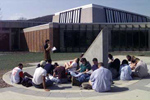 |
Binghamton |
New York |
USA |
Horizontal Dial |
Dial 404 |
| A 20-foot in diameter horizontal dial at ground level made of concrete. Part of the campus plaza. The gnomon is also concrete, approximately 8 inches wide and 5 foot tall. Place for students of SUNY Binghamton University to congregate. |
| |
| |
 |
Hamilton |
New York |
USA |
Horizontal Dial |
Dial 403 |
| A small brass horizontal dial 9 1/2 inches in diameter. Has a compass rose in the center. Hour lines branching to half hour and quarter hour. Roman numerals showing 5am to 7pm. To the south of the gnomon is a graph of the equation of time. Donated to Colgate University by Fred Sawyer. The dial sits upon a rectangular granite column. |
| |
| |
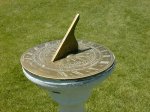 |
Mount Uniacke |
Nova Scotia |
Canada |
Horizontal Dial |
Dial 402 |
| A faithful fiberglass replica of an ornate bronze horizontal dial stands on the Uniacke Estate. The dial is about 40 cm diameter, with a sunburst in the center showing the 16 cardinal points and intricate markings typical of a 19th century dial. Surrounding the cardinal points is a ring engraved "Watch Faster, Watch Slower" with the equation of time. Roman numerals show the hours from V in the morning to VII at evening. This dial was made for Richard Uniacke in 1815, once the Attorney-General of Nova Scotia. The original dial may be in storage in Halifax. The inscribed latitude of 45:5N does not match the Uniacke Estate location. The wooden pedestal is in rather poor condition. |
| |
| |
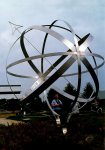 |
Rockford |
Illinois |
USA |
Armillary Sphere |
Dial 401 |
| A large stainless steel armillary dial approximately 10-ft (3m) in diameter. The equator and sunrise/sunset meridian bands are about 6in (15cm) wide, with other bands about 3-in (7.5cm) wide. The central gnomon is a stainless steel rod with an open shaped arrow point and tail. The hours on the equatorial ring are raised bronze roman numerals with 15-minute intervals marked by bronze dots. The time marks are set for daylight saving time, with sunset at VII. Marks continue to VIII |
| |
| |
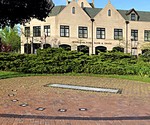 |
Highland Park |
Illinois |
USA |
Analemmatic Dial |
Dial 400 |
| A nicely done analemmatic dial approximately 15 feet across with a grey granite zodiac walkway. The granite walkway has a central line, crossed with month marks for standing at the date of the year. An unusual feature of the dial is that the Equation of Time (EoT) correcting solar time to civil time is given at the left and right edges of the dial. On the first, tenth, and twentieth of each month the EoT is inscribed to the nearest minute. The walkway is surrounded by one row of dark brick then encompassed by a large plaza of light red brick. Embedded in the plaza are small square Roman numeral hour marks, arranged for summer viewing with 1pm set to north. The plaza is in a nicely landscape area of grass, bushes, perennials, three large pots of flowers and a bench.. |
| |
| |
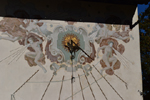 |
Centerport |
New York |
USA |
Vertical Dial |
Dial 399 |
| The vertical dial is a very colorful wall mural with a nautical theme. The wall faces south west with Roman numerals for hour marks. The gnomon is Neptune's trident supported by a very small three dimensional serpent. Summer and Winter solstices and Equinox are drawn on the dial. Above the dial is a mural of the four winds blowing. There is an ornate painted frame around the gnomon which itself is centered on a golden sun |
| |
| |
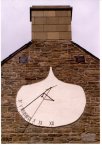 |
Fredericton |
New Brunswick |
Canada |
Vertical Dial |
Dial 397 |
| A vertical declining dial 7 x 7 feet with parged cement face and 5 foot wrought iron gnomon. Plaque on wall reads "The sundial at the top of this wall is a faithful reconstruction of the original which Frederictonians used during the 1800s and early 1900s. The shadow cast by the gnomon (style) onto the dial accurately displays local apparent solar time." An equation of Time is included on the plaque to determine mean time. The date of the original construction of this sundial is not known, but the Soldiers Barracks were built in 1826. The dial was restored in 1992. |
| |
| |
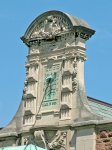 |
St. Louis |
Missouri |
USA |
Vertical Dial |
Dial 396 |
| A vertical decliner at the top of the Cupples I building. Given by the class of 1908. Can be seen from the courtyard of Robert S. Brookings building. In 1908 the campus newspaper, the Washington University Student Life, commented that "The new sun dial on Cupples I is now being put into position upon the tablet on the south side of the building?It will be interesting to note the discrepancy between sun time and standard time by comparing with the Varsity clock [a large time piece situated high on the west wall of Brookings Hall, with both clock and dial visible in the quadrangle]." Today the Baumont Pavilion, erected in 1965, blocks a close view of the ornate tablet and dial. Use binoculars from a distance. |
| |
| |
 |
St. Francesville |
Louisiana |
USA |
Horizontal Dial |
Dial 394 |
| A small 9 inch diameter brass horizontal dial sits on top of a cast iron pedestal. The dial face is worn, but readable with Roman numerals and 5-minute graduations. The dial plate is rotated about 40 degrees east of North. To the south of the gnomon is a 2 1/2 inch diameter mirror with unknown use. On left and right of the gnomon is scroll engraving of the equation of time. The dial sits on a 3 foot cast iron pedestal, painted adobe-red. A matching adobe-red dome cap with 8 sides covers the dial. Cap has an acorn handle lift. |
| |
| |
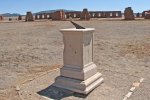 |
Fort Union |
New Mexico |
USA |
Compound Dial |
Dial 393 |
| A 2 foot square stone horizontal dial on a four foot high stone pedestal with vertical dials on its faces. This dial has been removed, replaced and relocated several times. The original gnomon was lost and replaced with an incorrect 45° gnomon, which has been replaced again with a steel gnomon that appears to be at slightly less than the correct latitude angle. All vertical dial gnomons are missing. The dial and a nearby inscribed stone are on the grounds of the Third Fort Union (1863-1891). The stone dial surfaces are worn from weather, but the Arabic hour numerals are still visible. |
| |
| |
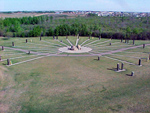 |
Lloydminster |
Alberta |
Canada |
Horizontal Dial |
Dial 392 |
| At 197 feet in diameter, this is one of the largest horizontal dials in North America. It's location is on the 4th meridian at 110:0 west, a line that separates Alberta and Saskatchewan and divides the city of Lloydminister in half. The gnomon is constructed from 8 inch black schedule 40 - carbon steel pipe that is painted yellow. It is 23 feet in length and is supported on a reinforced concrete base 30 inches wide and 8 feet long. It is surrounded by massive boulders partially buried in the ground. The giant hour lines are made of pavers laid on a sand and gravel base. The raised hour numbers are sandblasted on 16 inch square treated timber posts that are mounted in concrete. |
| |
| |
|
Louisbourg |
Nova Scotia |
Canada |
Horizontal Dial |
Dial 391 |
| A small horizontal dial 28 cm in diameter on a limestone pedestal. The dial shows local hours with half-hour lines from 4 am to 8 pm in Roman numerals. Trefoils are interspersed with the hour labels. A south-pointing crescent or moon sits across the sub-style and a representational daisy or sun sits below the center of the dial. The base is a limestone pedestal 85 cm tall. The base is a limestone pedestal 85 cm tall.
The dial is located in the Fortress of Louisbourg run by the Parks of Canada. The dial is a modern reproduction of a slate dial excavated at the site. |
| |
| |
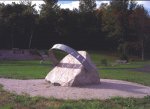 |
Branford |
Connecticut |
USA |
Equatorial Dial |
Dial 390 |
| This large equatorial dial was created as part of a community effort to establish a Natural Habitat park for the town of Branford. The dial is 7 x 6 x 6 feet made of Stony Creek granite and stainless steel, weighing 13,000 pounds. The granite is indigenous to the town. The face of the stone is cut at approximately 41 degrees to match the site latitude, inspired by a design from Robert Adzema "The Great Sundial Cutout Book". Dial shows time from 7 am until 5 pm. |
| |
| |
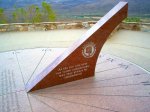 |
Bumble Bee |
Arizona |
USA |
Horizontal Dial |
Dial 389 |
| Horizontal dial approximately 10 feet in diameter. Made of concrete and granite. Commemorates Arizona Dept. of Transportation employees who were killed in the line of duty. |
| |
| |
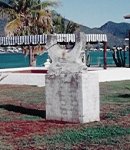 |
Guaymas |
Sonora |
Mexico |
Equatorial Dial |
Dial 388 |
| Dial is of stone, carved in a thick semi-circle ring about 200 degrees in extent. Dial is 36 inches in diameter and 10 inches thick. The inner rim of the dial is a "vee" shape. The gnomon is an iron rod protruding from the equatorial ring at the 12-hour mark, and at the center of the ring turns at a right angle to align to the north pole. The massive stone dial is set on a masonry block pedestal 40x40x20 inches. The pedestal is neither level nor cardinal. |
| |
| |
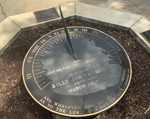 |
Jackson |
Mississippi |
USA |
Horizontal Dial |
Dial 387 |
| A large, 4-foot (1.2m) brass horizontal dial with clean lines. Time is marked in quarter hours from 5AM to 7PM. Hours are in Roman numerals. Dial sits in the middle of an octagon dais supported on a square concrete block. The gnomon is a simple blade, but the engraving on the dial says "Lat 39.3 N" and is clearly wrong. The dial honors Billy Jim Thompson for his support of the Academy. He died in 2014 at the age of 91. |
| |
| |
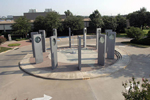 |
Dallas |
Texas |
USA |
Horizontal Dial |
Dial 385 |
| This is large horizontal dial with a 20-foot-long polar gnomon that rises obliquely from the center of a 34-foot-diameter circle. The hour lines are embedded in the terrazzo pavement showing hour marks and quarter hour ticks. Hour labels (standard time 6-7 and daylight-saving time 7-8) are etched into 12-inch diameter stainless steel plates, each tipped toward the dial's center and supported on a 6-inch-high bollard. The tick marks run further, extending from 5:30am to 7:15 standard time. Hour marks and labels are offset for site longitude, making the time correction between solar and civil time no more than +/- 15 minutes, depending on season. The stainless-steel gnomon has a rectangular cross section that tapers from 12 x 4 inches at the base to 4 x 4 inches at the upper end. The center of the gnomon's shadow (not the shadow's edge) indicates the time. The terrazzo circular plaza is slightly beveled (a squat cone) for proper runoff of rain. The cone's apex coincides with the base of the gnomon and is 10 inches higher than the circumference of the 34-foot circle. The layout of time lines takes this radially sloping surface into account. The terrazzo pavement also includes an embedded polar map of the world adjusted in longitude so that the longitude of Dallas with a star at the dial's location in Texas is due south of the gnomon. |
| |